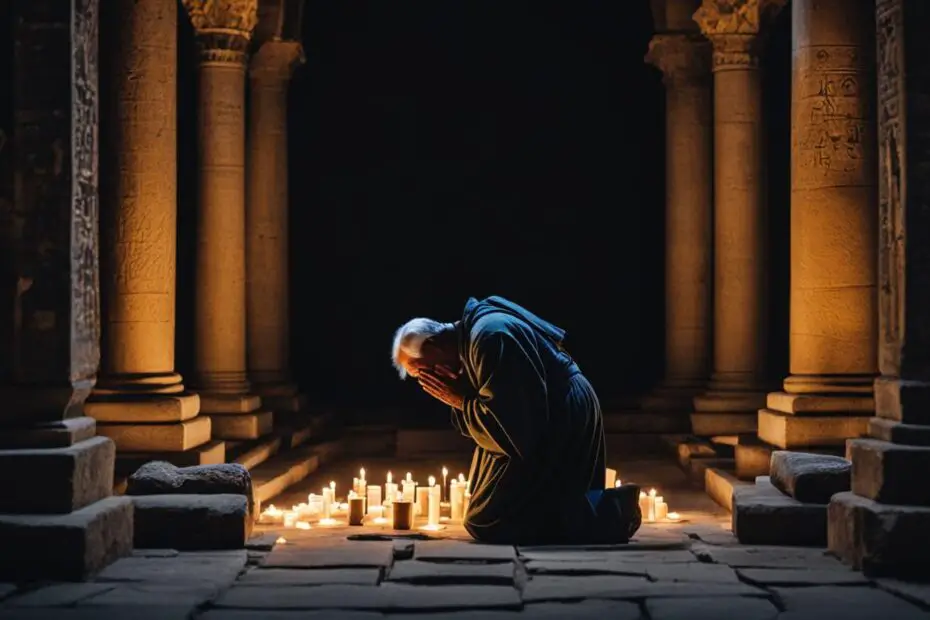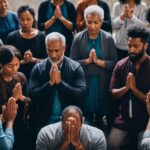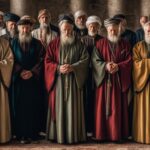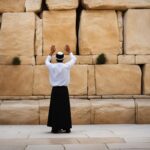Prayer has a profound historical significance, transcending time and cultures. Since the dawn of civilization, prayer has served as a means to connect with the divine, seek solace, and shape societies. From ancient rituals to modern-day practices, prayers throughout history have shaped beliefs, values, and traditions, leaving an indelible impact on human civilization.
In this article, we will delve into the historical significance of prayer and explore its evolution across different eras and cultural contexts. We will discover how prayer has not only provided individuals with guidance and strength but also fostered understanding and empathy among diverse communities.
Key Takeaways:
- Prayer has played a significant role in human civilizations throughout history.
- From ancient times to the present day, prayer has evolved and adapted to different cultural and religious contexts.
- Prayer has the power to provide comfort, guidance, and a sense of divine presence.
- It has a transformative impact on individuals’ well-being and mental health.
- Through prayer, people can find common ground and foster understanding among different cultures and religions.
The Power of Prayer in Ancient Times
In ancient civilizations, prayer played a profound role in the religious and spiritual landscape. It served as a means of communication with the divine, a way to seek guidance, protection, and blessings. Ancient prayers were deeply rooted in the cultural beliefs and values of each society, reflecting their hopes and fears. From the ancient Egyptians who meticulously recorded their prayers on papyrus scrolls to the Greeks and Romans who offered prayers to their gods and goddesses, prayer was an integral part of daily life.
These ancient prayers were often accompanied by rituals and offerings, further emphasizing their significance. They were not merely empty words, but heartfelt expressions of devotion and faith. Ancient cultures believed that through prayer, they could establish a personal connection with the divine and align themselves with higher powers.
“Prayer is exhaling the spirit of man and inhaling divine inspiration.”
The power of ancient prayers lay in their ability to instill a sense of hope, security, and purpose in individuals and communities. They provided solace during times of hardship and invoked divine intervention in times of need. Ancient civilizations understood the transformative potential of prayer, recognizing its ability to bring about positive change and influence the course of events.
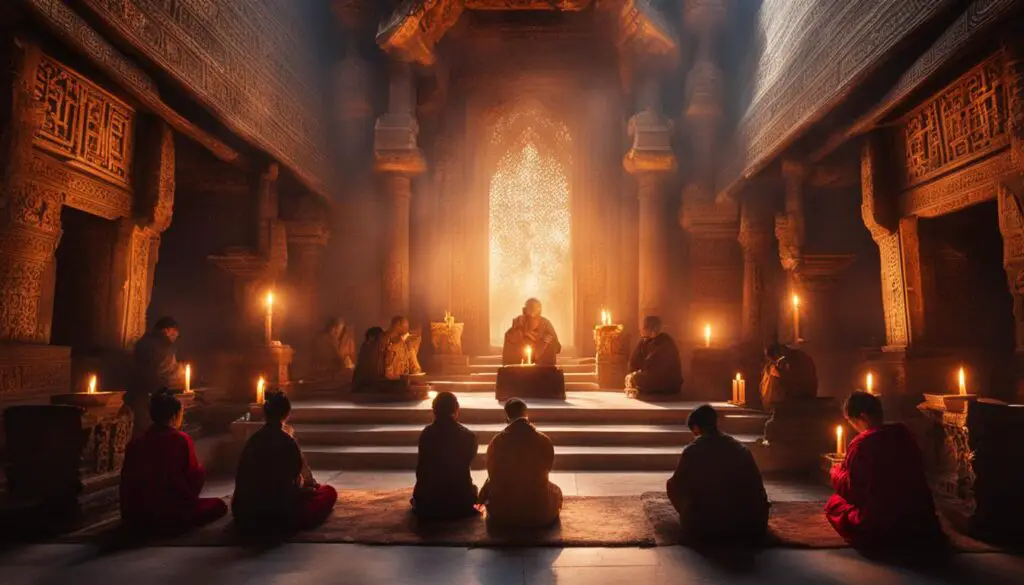
As we delve into the ancient prayers of different cultures, we gain a deeper appreciation for the role of prayer in shaping their values and traditions. From the intricate rituals of the Egyptians to the poetic verses of the Greeks, each civilization embraced prayer as an essential element of their spiritual and cultural identity.
Ancient Egyptian Prayers: Connecting with the Divine
The ancient Egyptians possessed a rich spiritual cosmology, with a pantheon of gods and goddesses governing various aspects of life. Prayer for the Egyptians was a way to establish a relationship with these deities and seek their favor. They believed that by offering prayers, they could communicate their needs, express gratitude, and request divine guidance.
The sacred rituals and prayers recorded on papyrus scrolls reveal the devotion of the Egyptians to their gods and goddesses. These prayers sought protection, healing, and prosperity for the individuals and the kingdom as a whole. They demonstrate the profound influence of religious beliefs on daily life in ancient Egypt and the central role of prayer in fostering a connection with the divine.
Greek and Roman Prayers: Honoring the Olympian Deities
The ancient Greeks and Romans worshipped a pantheon of gods and goddesses known as the Olympians. Prayer was a regular part of their religious practices and played a vital role in seeking divine intervention and blessings. They offered prayers at temples, during public events, and in private settings.
The Greeks believed that through prayer, they could establish a relationship with the gods and goddesses, seeking their favor and guidance. The Homeric hymns, poetic prayers dedicated to individual deities, exemplify the heartfelt devotion of the ancient Greeks and their desire for divine assistance in various aspects of life.
The Romans, influenced by Greek culture, also embraced prayer as a vital component of their religious tradition. They had complex rituals and prayers dedicated to the gods and goddesses, seeking protection, success, and prosperity. Emperors, senators, and citizens would offer prayers to secure the favor of the gods for the empire and their personal lives.
Ancient Greek and Roman prayers often involved offerings, such as incense, food, or libations. These offerings symbolized their reverence and gratitude towards the gods, establishing a reciprocal relationship between mortals and the divine.
Prayer in Cultures Around the World: A Universal Practice
The power of prayer observed in ancient times is not unique to a particular culture or civilization. Prayer has been a universal practice across different cultures and continents, often embodying shared human desires for connection, guidance, and transcendence. From Native American tribes to indigenous communities in Africa, Asia, and the Americas, prayer has served as a means of expressing faith, seeking spiritual enlightenment, and maintaining a sense of harmony with nature.
“Prayer is the key to the morning and the bolt of the evening.”
Prayer in ancient times exemplified the intrinsic human need for spiritual connection and the recognition of forces greater than oneself. It played a pivotal role in nurturing the religious and cultural fabric of societies, shaping their values, traditions, and worldview.
Table: Ancient Prayers and Rituals
| Culture | Ancient Prayer | Key Themes |
|---|---|---|
| Egyptian | Hymn to the Sun God | Prayer for guidance, protection, and blessings |
| Greek | Homeric Hymns | Praise and invocation of different gods and goddesses |
| Roman | Prayer to Jupiter Optimus Maximus | Prayer for success, prosperity, and divine favor |
These ancient prayers reflect the cultural and religious ethos of their respective civilizations, capturing the hopes, fears, and aspirations of ancient societies. They provide us with profound insights into the role of prayer in shaping human history and development over thousands of years.
The Evolution of Prayer in Different Eras
Throughout history, prayer has continuously evolved alongside the development of societies and religions. As organized religions emerged and gained prominence, prayer practices became more formalized and structured. In the Middle Ages, prayer took on a new significance within the context of Christianity, Islam, and Judaism.
“Prayer is the key of the morning and the bolt of the evening.”
– Mahatma Gandhi
During this era, prayer books such as the Books of Hours became popular tools to guide individuals in their daily prayers and devotions. These books contained specific prayers tailored for different times of the day and various occasions. They served as a reflection of the religious and cultural norms of the time, offering individuals a structured framework for their prayer practices.
To better understand the evolution of prayer practices in different eras, let’s take a closer look at the Books of Hours:
| Features of the Books of Hours | Importance |
|---|---|
| Specific prayers for different hours of the day (matins, lauds, prime, etc.) | Guided individuals in consistent daily prayer routines. |
| Inclusion of psalms, hymns, and biblical passages | Deepened individuals’ connection with sacred texts. |
| Inclusion of illuminations and artistic embellishments | Elevated the spiritual experience and visually captured the devotion. |
These prayer books were not only aids for personal devotion but also served as status symbols, demonstrating one’s piety and social standing.
The enduring legacy of the Books of Hours
The Books of Hours represent a significant chapter in the historical development of prayer practices. Their influence extended beyond the Middle Ages and continued to shape prayer traditions in subsequent eras. The structured nature of these books set a precedent for organized religious practices.
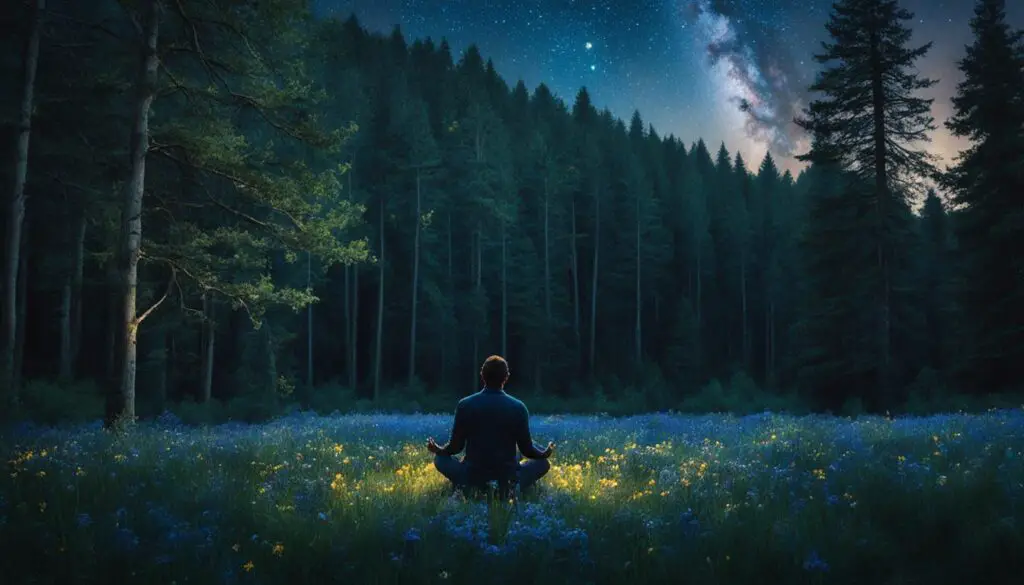
The Books of Hours were a reflection of the importance of prayer in different eras, revealing the historical significance of prayer as a guiding force in people’s lives. They remind us that prayer has always been a vital aspect of human spirituality, providing individuals with a means to connect with the divine, seek solace, and express gratitude.
Prayer and Devotion in Renaissance and Enlightenment
During the Renaissance and Enlightenment periods, prayer continued to hold a significant place in religious and intellectual life. The historical significance of prayer was acknowledged as it was seen as a powerful way to connect with the divine and embark on a spiritual journey towards enlightenment.
As humanism emerged during this time, there was an increased emphasis on personal prayer and self-reflection. Individuals sought a deeper understanding of themselves and their relationship with the divine, engaging in prayer rituals to cultivate inner growth and spiritual connection.
Prayer rituals in the Renaissance and Enlightenment often involved the use of prayer beads, which served as a tangible aid in focusing the mind and guiding one’s thoughts. These beads allowed individuals to engage in repetitive recitation of specific prayers, creating a meditative and contemplative atmosphere.
Furthermore, prayer played a role in shaping intellectual discourse during this era. Philosophers and thinkers, such as René Descartes and Sir Isaac Newton, acknowledged the significance of prayer in their explorations of the natural world, seeking divine guidance and inspiration.
“Prayer is not asking. It is a longing of the soul. It is daily admission of one’s weakness. It is better, in prayer, to have a heart without words than words without a heart.”
– Mahatma Gandhi
The Renaissance and Enlightenment periods were characterized by a merging of religious and intellectual pursuits, allowing individuals to approach prayer as a means to bridge the gap between the earthly and the divine. This integration of spirituality and reason fostered a holistic approach to prayer and devotion, recognizing the interconnectedness of the physical and spiritual realms.
| Prayer Rituals in Renaissance and Enlightenment | Historical Significance |
|---|---|
| Use of prayer beads | Facilitated focused meditation and reflection |
| Meditative recitation of specific prayers | Encouraged contemplative connection with the divine |
| Inclusion of prayer in intellectual pursuits | Recognized the importance of divine inspiration in knowledge-seeking |
Overall, the Renaissance and Enlightenment periods showcased the continued importance of prayer as a means to connect with the divine and seek spiritual enlightenment. These historical eras emphasized personal introspection, the use of prayer aids, and the integration of prayer with intellectual pursuits. The rituals and practices during this time reflected the deep spiritual yearning of individuals and cultivated a profound connection between the earthly and the divine.
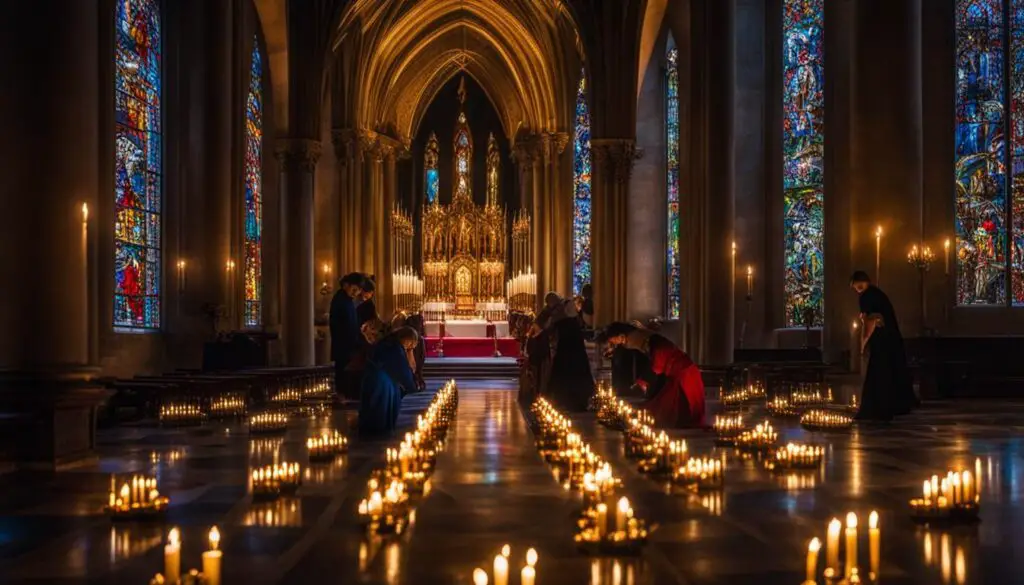
Prayer in Modern Times
Prayer has evolved and adapted to the modern era, embracing technological advancements and accommodating diverse beliefs and practices. With the rise of electronic devices and online platforms, individuals now have easy access to a wide array of prayers and meditations at their fingertips. Whether it’s through prayer apps, websites, or social media platforms, modern technology has made prayer more accessible and convenient than ever before.
In addition to technological advancements, prayer has also become more inclusive. It now encompasses a broad spectrum of belief systems and spiritual practices, catering to the diverse needs and preferences of individuals. From traditional congregational prayers in religious institutions to private, personal prayers, people now have the freedom to express their spirituality in ways that resonate with their unique beliefs and spiritual journeys.
In modern times, individuals can engage in prayer practices that align with their personal beliefs and needs. While some still find solace and community in traditional forms of prayer, others may opt for more personal and intimate forms of prayer that suit their individual spiritual paths. Whether it’s through mindfulness practices, guided visualizations, or personal affirmations, modern prayer practices allow individuals to connect with the divine and find inner peace in their own way.
“Prayer is not asking for what you think you want, but asking to be changed in ways you can’t imagine.” – Kathleen Norris
Inclusive Prayer Communities and Virtual Gatherings
One notable aspect of modern prayer practices is the rise of inclusive prayer communities and virtual gatherings. These platforms allow people from different backgrounds and belief systems to come together and engage in communal prayer experiences. Whether it’s through video conferencing, online forums, or social media groups, individuals can connect with like-minded individuals and participate in shared prayer rituals and meditations.
This virtual connectivity not only fosters a sense of community but also transcends geographical barriers, allowing individuals to engage in prayer experiences from the comfort of their own homes. People can join online prayer circles, participate in global meditation events, or seek solace and support through virtual prayer groups. Virtual prayer communities provide a space for individuals to connect, share, and grow spiritually, regardless of their physical locations.
Evolution of Prayer Practices in Modern Times
| Traditional Prayer Practices | Modern Prayer Practices |
|---|---|
|
|
 |
As the world continues to change and evolve, prayer practices in modern times will continue to adapt and embrace new opportunities for connection and growth. Whether it’s through technology-driven innovations or the creation of inclusive prayer communities, prayer remains a powerful and transformative tool for individuals seeking spiritual fulfillment and inner peace.
Prayer Across Cultures and Religions
Prayer is a universal phenomenon that transcends cultural and religious boundaries. It is a deeply personal and spiritual practice that holds different meanings and forms across diverse cultures and religions. From Christian prayer circles to Buddhist meditation practices, from Muslim Salah to Hindu puja, prayer takes various expressions that reflect the unique traditions, rituals, and beliefs of each culture. Regardless of the distinctiveness, the underlying purpose of prayer remains the same – to connect with the divine, seek guidance, and express gratitude.
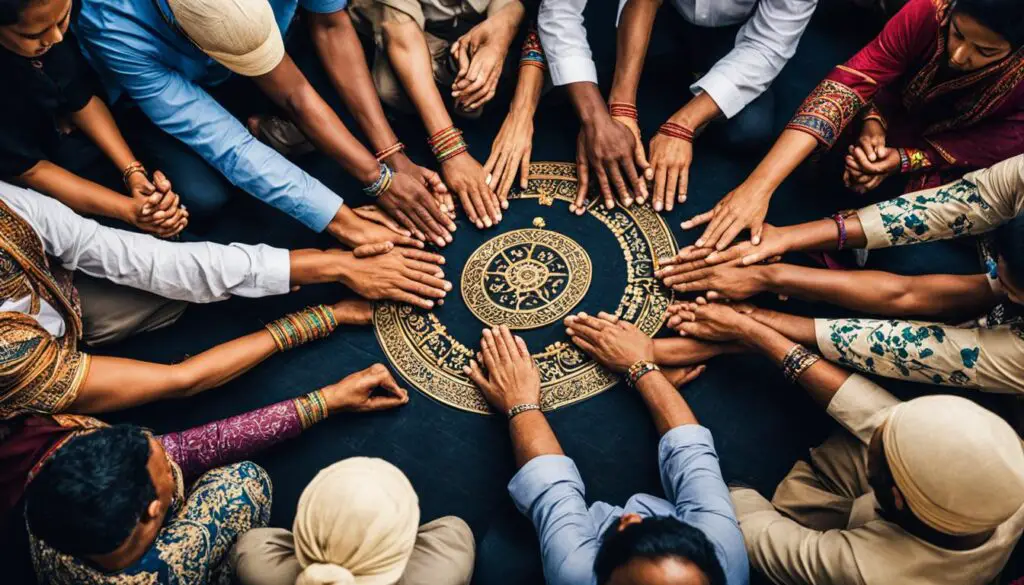
Each culture and religion has its specific rituals, gestures, and words that hold deep spiritual significance. For example, in Islam, the Salah (prayer) involves specific physical postures, recitations from the Quran, and facing towards the Kaaba in Mecca. In Hinduism, prayer is often accompanied by elaborate ceremonies, offerings, and the ringing of bells in temples. Christian prayer circles bring believers together in communal prayer, fostering a sense of unity and support. These diverse practices reflect the deep-rooted spirituality and the values of love, devotion, and reverence.
“Prayer is not asking. It is a longing of the soul. It is daily admission of one’s weakness. It is better in prayer to have a heart without words than words without a heart.” – Mahatma Gandhi
Prayer in different cultures not only serves as a means of communication with the divine, but it also encompasses various forms of meditation, contemplation, and mindfulness. Buddhist meditation practices, such as Zen and Vipassana, focus on cultivating awareness, peace, and inner stillness. Native American traditions often involve prayer ceremonies that connect individuals with the spiritual forces of nature and the ancestors. These diverse practices reflect the rich tapestry of human spirituality and the innate human quest for connection, meaning, and transcendence.
The Power of Prayer in Unity
One of the remarkable aspects of prayer across cultures and religions is its ability to unite individuals and communities. It serves as a common thread that weaves through the fabric of varied traditions, fostering a sense of shared humanity and interconnectedness. When people from different backgrounds come together to share their prayer practices and experiences, they gain insights into each other’s beliefs, values, and cultural perspectives. This intercultural exchange creates opportunities for dialogue, compassion, and collaboration, ultimately strengthening the bonds of diverse communities.
The Enduring Significance of Prayer
The diversity of prayer practices across cultures and religions highlights the enduring significance of prayer throughout human history. It demonstrates the timeless power of prayer to guide, heal, and transform lives. Regardless of the specific rituals or words used, prayer serves as a source of solace, inspiration, and spiritual growth. It reminds us of the shared human experience, the interconnectedness of all beings, and the quest for a deeper meaning that transcends cultural boundaries.
The Transformative Power of Prayer
Prayer holds within it a transformative power that reaches beyond the superficial aspects of our lives. It provides individuals with the strength necessary to navigate the challenges and uncertainties that they face, offering solace and peace in times of distress. Scientific studies have delved into the effects of prayer on mental health and have found that it holds significant benefits for overall well-being.
Research has shown that engaging in prayer can reduce stress levels, helping individuals find a sense of calm amidst the chaos of daily life. Through prayer, individuals can tap into the deep reservoirs of their inner selves, unburdening themselves of worries and concerns. This release of stress promotes a state of tranquility, allowing individuals to find a sense of peace and balance within themselves.
Furthermore, prayer has been linked to increased resilience, enabling individuals to navigate through difficult times with greater strength and fortitude. The act of prayer connects individuals to a higher power, instilling in them a deep sense of purpose and meaning. This connection fosters a sense of hope, empowering individuals to face challenges head-on and persevere in times of adversity.
“Prayer is not asking. It is a longing of the soul. It is daily admission of one’s weakness. It is better in prayer to have a heart without words than words without a heart.” – Mahatma Gandhi
For many, prayer serves as a source of comfort and reassurance, reminding them of a divine presence that walks alongside them through life’s trials and tribulations. It provides a sense of guidance and support, offering solace in moments of doubt and uncertainty. The transformative power of prayer lies in its ability to instill a deep sense of trust and faith in the universe, allowing individuals to surrender their troubles and find strength in the belief that they are not alone.
| Benefits of Prayer |
|---|
| Reduces stress levels |
| Increases feelings of peace and calm |
| Improves overall resilience |
| Provides a source of hope and solace |
Prayer transcends the confines of religion and culture, offering its transformative power to anyone who seeks it. Whether through traditional religious practices or personal expressions of spirituality, prayer has the capacity to nourish the soul and uplift the spirit. In times of darkness, it shines a light that illuminates the path forward, bolstering individuals’ abilities to overcome obstacles and find resilience in the face of adversity.
Embrace the transformative power of prayer and allow it to infuse your life with strength, hope, and a profound sense of connection to something greater than yourself. Through prayer, you can experience the gift of inner transformation, unlocking your true potential and discovering the boundless possibilities that await.
Prayer in History: Lessons for the Present
The study of prayer in history provides us with valuable insights and teachings that are highly relevant to the present day. It reminds us of the enduring human need for connection, reflection, and transcendence. Through the centuries, prayer has served as a powerful tool for individuals and communities, offering guidance, solace, and hope.
One of the timeless wisdoms we can learn from prayer in history is the power of faith. Throughout different eras and cultures, prayer has been a gateway to a deeper spiritual connection and a source of unwavering faith. It teaches us that in times of doubt or uncertainty, a steadfast belief in the divine can provide strength and resilience.
The power of prayer lies not in changing the world around us, but in transforming ourselves and our perspective.
Another crucial lesson we can glean from prayer in history is the importance of hope. In the face of adversity, prayer has served as a beacon of hope, reminding individuals and communities that there is always a glimmer of light amidst darkness. It encourages us to hold on to hope, even in the most challenging of circumstances.
Prayer also teaches us the significance of gratitude. In expressing gratitude through prayer, we acknowledge the blessings and grace we receive, fostering a sense of appreciation and contentment. It reminds us to cultivate gratitude in our daily lives, shifting our focus towards the positive aspects and fostering a sense of inner peace.
“When you arise in the morning, think of what a precious privilege it is to be alive, to breathe, to think, to enjoy, to love.” – Marcus Aurelius
Furthermore, prayer has been a catalyst for positive change and social transformation throughout history. It has inspired countless individuals to take action, sparking movements for justice, compassion, and equality. Prayer has the power to unite people, transcending differences and creating a common ground for shared values and aspirations.
By delving into the historical significance of prayer, we gain a deeper appreciation for its role in shaping human civilizations. We recognize the enduring impact it has had on individuals and communities, and we can apply these lessons to our own lives today. Prayer reminds us that despite the ever-changing world, certain timeless values and practices can guide us towards a more meaningful and purposeful existence.
“Prayer is not asking. It is a longing of the soul. It is daily admission of one’s weakness. It is better in prayer to have a heart without words than words without heart.” – Mahatma Gandhi
In conclusion, prayer in history offers invaluable lessons for the present. It leads us to reflect on the enduring human need for connection, faith, hope, and gratitude. It demonstrates the transformative power of prayer and its capacity to drive positive change. By embracing the timeless wisdom of prayer, we can cultivate a deeper sense of purpose, connection, and well-being in our lives, allowing us to navigate the complexities of the modern world with greater resilience and wisdom.
The Diversity of Prayer Experiences
Prayer is a deeply personal and individual experience, and it can manifest in a variety of ways. The diversity of prayer experiences reminds us that there is no one-size-fits-all approach to prayer. Different individuals find solace, connection, and meaning in different ways. Whether it’s through traditional religious prayers and rituals, silent meditation or contemplation, artistic expression, or communal prayer, each person has the freedom to seek their own unique path to connect with the divine.
Traditional Religious Practices
For many individuals, traditional religious prayers and rituals are an essential part of their prayer experience. These practices, rooted in the teachings and traditions of their faith, provide a sense of structure, guidance, and familiarity. Whether it’s reciting specific prayers, performing rituals, or participating in congregational worship, these practices offer a sacred space for individuals to express their devotion and seek a deeper connection with the divine.
Silent Meditation and Contemplation
Some individuals find solace and connection through silent meditation and contemplation. These practices involve stilling the mind, focusing on the breath, and entering a state of deep reflection and connection with one’s inner self and the spiritual realm. Silent meditation allows individuals to explore their thoughts, emotions, and spiritual experiences in a quiet and introspective way.
Expressing Prayers Through Art, Music, or Movement
Prayer can also be expressed through art, music, or movement. Creating visual art, playing musical instruments, singing hymns or devotional songs, and engaging in rhythmic movements can be powerful forms of prayer for individuals who are more visually or kinesthetically inclined. These creative expressions provide a unique channel for individuals to communicate and connect with the divine.
Communal Prayer and Group Gatherings
For many, communal prayer and group gatherings are a source of strength, support, and unity. Coming together with others who share the same faith or spiritual beliefs creates a sense of community and shared purpose. Whether it’s participating in religious services, prayer circles, or group meditation sessions, communal prayer allows individuals to draw strength from the collective energy and support of like-minded individuals.
As seen from the diverse ways people choose to pray, there is no right or wrong way to connect with the divine. Each individual has the freedom to explore and find their own unique path, embracing prayer practices that resonate with their beliefs and spirituality. It is through this diversity of prayer experiences that we can appreciate the richness and depth of the human desire for connection, meaning, and transcendence.
Prayer as an Intercultural Bridge
Prayer has the remarkable ability to transcend cultural and religious boundaries, serving as a powerful bridge that fosters understanding and empathy among individuals from diverse backgrounds. When people gather and share their prayer practices, they gain profound insights into each other’s beliefs, values, and traditions, breaking down barriers and creating a sense of unity.
Prayer acts as a common ground that allows people to connect on a deeper level, reaching beyond superficial differences and embracing the shared human experience. It provides a unique opportunity for dialogue, compassion, and collaboration, opening doors for meaningful interactions and fostering genuine connections among individuals of varied cultures and religions.
“Prayer is not asking. It is a longing of the soul. It is daily admission of one’s weakness. It is better in prayer to have a heart without words than words without a heart.” – Mahatma Gandhi
The act of praying together cultivates a sense of empathy and respect, enabling individuals to appreciate the richness and diversity of human spirituality. Through prayer, people learn to honor and value different belief systems, celebrating the beauty of multitudes of perspectives. This celebration of diversity strengthens the fabric of communities, leading to greater understanding, harmony, and collaboration.
Just as the intertwining branches of a tree create a wholesome canopy, prayer weaves together the hearts and souls of individuals, forming a tapestry of interconnectedness. It is through prayer that we realize our shared aspirations, our shared hopes for peace, love, and compassion in our world.
Let us embrace prayer as an intercultural bridge, allowing it to guide us towards a future built on mutual respect, understanding, and unity.
| Benefits of Prayer as an Intercultural Bridge | Examples |
|---|---|
| Enhances cultural knowledge and understanding | Prayer circles that bring people of different faiths together |
| Promotes empathy and compassion | Interfaith prayer services dedicated to social justice causes |
| Builds bridges of trust and friendship | Interreligious dialogue facilitated through communal prayer |
| Fosters collaboration in addressing common challenges | Joint prayer initiatives for environmental conservation |
Through prayer, we can build a world where cultural and religious diversity is not seen as a source of division, but as a catalyst for deeper connections and shared growth. Together, let us embark on a journey of understanding, embracing prayer as the transformative force that brings us closer to one another.
Prayer’s Enduring Legacy
The legacy of prayer is a testament to its profound impact on history and human civilizations. Throughout time, prayer has served as a source of comfort, hope, and guidance, addressing the deepest needs and aspirations of individuals and communities. From the whispered prayers for peace during times of war to the heartfelt pleas for healing during times of illness, prayer has been a powerful force that transcends boundaries and unites people in their shared humanity.
Prayer has sparked social movements, igniting the flame of change and inspiring individuals to stand up for justice and compassion. It has moved hearts and minds, shaping the course of history and influencing political landscapes. From the Civil Rights Movement led by figures like Martin Luther King Jr., who fervently prayed for equality and freedom, to the prayers of activists fighting for environmental preservation, prayer has been a catalyst for transformative action.
Moreover, prayer has left an indelible mark on the traditions, rituals, and beliefs of various cultures and religions. It has given rise to sacred practices and disciplines, enriching the spiritual lives of individuals and communities. Through prayer, people have established deep connections with the divine, finding solace, strength, and purpose in their journey of faith.
The enduring legacy of prayer is a testament to its timeless power and relevance. It reminds us that prayer has been an integral part of the human experience since ancient times, and its impact continues to resonate in our lives today. Whether through the solemn chants of Buddhist monks, the fervent communal prayers of a church congregation, or the quiet contemplation of a solitary seeker, prayer reminds us of our shared humanity and our longing for something beyond the material world.
“Prayer is not asking. It is a longing of the soul. It is daily admission of one’s weakness. It is better in prayer to have a heart without words than words without a heart.” – Mahatma Gandhi
Prayer’s enduring legacy calls us to reflect on its profound influence throughout history and encourages us to cultivate a rich prayer life in our own journeys. It invites us to experience the transformative power of prayer and discover the sacred connection it offers to a greater purpose.
| Prayer’s Impact on History | Examples |
|---|---|
| Igniting Social Movements | The Civil Rights Movement, the Anti-Apartheid Movement in South Africa |
| Shaping Political Change | The prayers for peace during the Vietnam War, the prayers for freedom during Apartheid in South Africa |
| Inspiring Acts of Compassion and Justice | Prayer services for victims of natural disasters, prayers for reconciliation in conflict-torn regions |
| Building Bridges Across Communities | Interfaith prayer gatherings, prayer events promoting peace and understanding |
Conclusion: The Timeless Power of Prayer
In conclusion, prayer has left an indelible mark on the tapestry of human history. Across millennia, it has served as a steadfast companion for individuals and communities, offering solace in times of distress, fostering connection with the divine, and providing guidance on life’s journey. From ancient civilizations to modern times, prayer has seamlessly adapted to different cultural contexts, demonstrating its enduring relevance and impact.
Studying prayer throughout history unveils the profound role it has played in shaping human civilizations. It reveals prayer’s transformative power, helping individuals grow spiritually, find strength in times of adversity, and build communal bonds. Through prayer, people have sought wisdom, cultivated gratitude, and found the courage to stand up for justice and compassion.
Today, prayer continues to be a cornerstone of personal and communal growth. It offers a sanctuary for introspection, a bridge between different faiths and cultures, and a source of comfort amidst uncertainty. As we delve into the history of prayer, we gain a deeper understanding of its timeless wisdom and unlock the potential it holds to enrich our lives, both individually and collectively.
FAQ
What is the historical significance of prayer?
Prayer has played a significant role in human civilizations throughout history, shaping beliefs, values, and traditions. It has provided solace, guidance, and a connection to the divine for countless individuals and communities.
How has prayer evolved over time?
Prayer practices have evolved and adapted to different cultures and eras. From ancient rituals to modern-day practices, prayer has taken various forms and expressions, reflecting the changing religious and spiritual landscape.
What were prayer rituals like in ancient times?
In the past, prayer rituals were deeply intertwined with religious and spiritual beliefs. They involved offerings, specific gestures, and the recitation of prayers to communicate with the divine, seek guidance, protection, and blessings.
How did prayer change in the Middle Ages?
In the Middle Ages, prayer became more formalized and structured within organized religions. Books of Hours emerged as a popular way to guide individuals in their daily prayers and devotions, reflecting religious and cultural norms of the time.
What role did prayer play in the Renaissance and Enlightenment?
During the Renaissance and Enlightenment, prayer continued to be a significant part of religious and intellectual life. It was seen as a means to connect with the divine, seek spiritual enlightenment, and engage in personal reflection.
How is prayer practiced in modern times?
In modern times, prayer has taken on various forms. With advances in technology, individuals can access prayers and meditation practices online. Prayer has also become more inclusive, accommodating diverse belief systems and spiritual practices.
How does prayer differ across cultures and religions?
Different cultures and religions have their unique prayer practices, rituals, and words that hold deep spiritual significance. From Christian prayer circles to Buddhist meditation practices, prayer takes different forms and expressions across cultural and religious contexts.
What impact does prayer have on well-being?
Scientific studies indicate that prayer can reduce stress, increase feelings of peace and calm, and improve overall well-being. It is believed to tap into the power of the mind and create a sense of connection and purpose.
What can we learn from studying prayer in history?
The study of prayer in history offers insights into the enduring human need for connection, reflection, and transcendence. It teaches us about the power of faith, hope, and gratitude and how prayer has influenced positive change throughout history.
How can individuals experience prayer?
Prayer is a deeply personal and individual experience that can manifest in various ways. Some find solace in traditional religious prayers and rituals, while others prefer silent meditation or contemplation. It can be expressed through art, music, movement, or communal prayer.
How can prayer foster understanding among different cultures?
Prayer can bridge cultural and religious divides by allowing people of different backgrounds to connect on a deeper level. It creates opportunities for dialogue, compassion, and collaboration, fostering understanding and empathy.
What is the enduring legacy of prayer?
Prayer has had an enduring impact on history and human civilizations, providing comfort, hope, and guidance. It has inspired social movements, influenced political change, and sparked acts of compassion and justice, leaving behind a timeless legacy.


